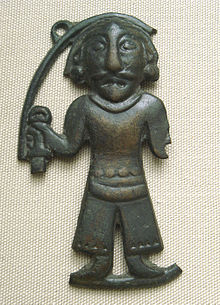Ordos kültürü

Ordos kültürü (basitleştirilmiş Çince: 鄂尔多斯文化; geleneksel Çince: 鄂爾多斯文化) Ordos Havzası merkezli bir bölgeyi işgal eden maddi bir kültürdü (kuzeydeki Baotou da dahil olmak üzere Suiyuan bölgesine karşılık gelir ve tümü modern İç Moğolistan, Çin'de bulunur).[2] Bronz ve Erken Demir Çağı'nda, MÖ 6. yüzyıldan 2. yüzyıla kadar. Ordos kültürü, İskit sanatının önemli buluntularıyla bilinir ve Saka[3][4][5] gibi Hint - Avrupa Avrasya göçebelerinin en doğudaki uzantısını temsil edebilir veya Paleo-Sibiryalılar veya Yenisiyalılarla ilişkilendirilebilir.[6] Çin ve Han hanedanları döneminde bölge, çağdaş Çin devletlerinin kontrolü altına girdi.
Kaynakça[değiştir | kaynağı değiştir]
- ^ Maenchen-Helfen, Otto; Helfen, Otto (1 Ocak 1973). The World of the Huns: Studies in Their History and Culture (İngilizce). University of California Press. s. 371. ISBN 978-0-520-01596-8. 13 Mayıs 2023 tarihinde kaynağından arşivlendi. Erişim tarihi: 24 Ekim 2023.
- ^ The Silk Road Encyclopedia (İngilizce). Seoul Selection. 18 Temmuz 2016. s. 1959. ISBN 978-1-62412-076-3. 28 Ağustos 2023 tarihinde kaynağından arşivlendi. Erişim tarihi: 24 Ekim 2023.
- ^ Lebedynsky 2007, s. 131
- ^ Macmillan Education 2016, s. 369 "From that time until the HAN dynasty the Ordos steppe was the home of semi-nomadic Indo-European peoples whose culture can be regarded as an eastern province of a vast Eurasian continuum of Scytho-Siberian cultures."
- ^ Harmatta 1992, s. 348: "From the first millennium b.c., we have abundant historical, archaeological and linguistic sources for the location of the territory inhabited by the Iranian peoples. In this period the territory of the northern Iranians, they being equestrian nomads, extended over the whole zone of the steppes and the wooded steppes and even the semi-deserts from the Great Hungarian Plain to the Ordos in northern China."
- ^ "The genetic and linguistic evidence for the xiongnu-yenisseian hypothesis". ResearchGate (İngilizce). 28 Ağustos 2023 tarihinde kaynağından arşivlendi. Erişim tarihi: 1 Şubat 2022.
